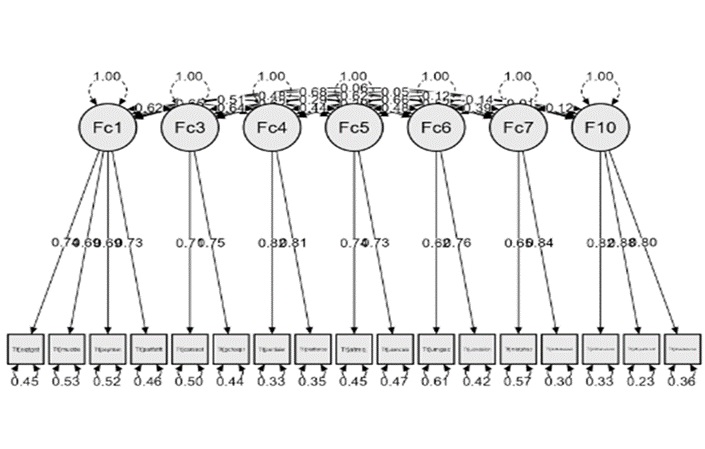Exploratory and Confirmatory Factor Analysis of Student Teacher Evaluation Questionnaire (STEQ) for Teacher

DOI:
https://doi.org/10.54060/a2zjournals.jase.38Keywords:
Teachers’ evaluation tool, questionnaire, factor analysis, Soccsksargen Region, STEQAbstract
Philippines currently facing a learning crisis in the K to 12 evaluations. With explora-tory and confirmatory factor analysis, this study developed a teacher evaluation questionnaire for effective teaching mathematics. Participants are coming from math teachers (N1 = 65), students (N2 = 76), principals and math supervisors (N3 = 61). Exploratory factor Analysis identified 15 factors. Multiple factor characteristics and literature provides support for 61 items on 15 factors. Confirmatory factor analy-sis, using the second sample (N=202), examined the 15-factor model identified from the exploratory factor analysis. Fit indices were used to evaluate the model fit, and these indices were able to identify the seven most fit factors. The Cronbach alpha coefficient is (0.903) excellent from the third sample (N=71). These analyses provide support for the seven-factor structure of the final 17-items STEQ, which will serve as a valuable classroom teacher evaluation tool for both supervisors and researchers to assess teachers teaching effectiveness in the Southern part of Mindanao. It is rec-ommended to utilize the STEQ to determine effective teachers in teaching mathe-matics to elevate the numeracy performance of the country.
Downloads
References
K. Gonzalez & G. Maxwell, “Mathematics teachers’ efficacy, experience, certification and their impact on student achievement, vol.21, pp.1-11, 2018.
K. E. Jalilova, “THE METHODS AND AIDS IN THE PRESENTATION OF TEACHING MATERIALS OF TEACHING ENGLISH,” Экономика и социум, vol.1, no.80, 2021.
L. Kohnke & B. L. Moorhouse, “Facilitating Synchronous Online Language Learning through Zoom,” RELC Journal, vol.53, no.1, 2020.
R. G. B. You, K. Varaklis, V. Hayes, et al., “The Feedback Tango,” vol.93, no.4, pp.657–663, 2017.
The Role of Learning Progressions in Competency-Based Pathways, 2015. http://www.achieve.org/files/Achieve-LearningProgressionsinCBP.pdf
Positive Behavior Strategies: An Approach for Engaging and Motivating Students – NCLD, 2021.https://ncld.org/reports-studies/forward-together-2021/positive-behavior-strategies.
A. S. Munna & A. Kalam, “Teaching and learning process to enhance teaching effectiveness: a literature review,” International Journal of Humanities and Innovation (IJHI), vol.4, no.1, pp.1–4, 2021.
K. Rogers, “The Effects of Classroom Seating Layouts on Participation and Assessment Performance in a Fourth Grade Classroom,” Journal of Learning Spaces, vol.9, no.1, 2020.
D. Kay and J. Kibble, “Learning theories 101: application to everyday teaching and scholarship,” Adv. Physiol. Educ., vol. 40, no. 1, pp. 17–25, 2016.
R. C. Schoen and M. LaVenia, “Teacher beliefs about mathematics teaching and learning: Identifying and clarifying three constructs,” Cogent Educ., vol. 6, no. 1, p. 1599488, 2019.
B. Greenwood, “What is Behaviourism and How to Use it in the Classroom, 2020.Teamsatchel.com. https://blog.teamsatchel.com/what-is-behaviourism-and-how-to-use-it-in-the
Z. Al. Shammari, P. E. Faulkner & C. Forlin, “Theories-based Inclusive Education Practices,” Ssrn.com, 2019. https://papers.ssrn.com/sol3/papers.cfm?abstract_id=3415247
U. Regents, “Learning: Theory and Research in This Section Overview of Learning Theories Behaviorism Cognitive Constructivism Social Constructivism Neuroscience and How Students Learn Cognitive Science: Memory and Learning Anthropology: Situated Learning in Communitie,” 2016. http://gsi.berkeley.edu/media/Learning.pdf
J. H. Stronge, “Qualities of effective teachers,” Ascd, pp.1-10, 2018.
C. Kooloos, H. O. Marchand, S. V. Boven, et al., “Making sense of student mathematical thinking: the role of teacher mathematical thinking,” Educ Stud Math, vol.110, pp.503–524, 2022.
P. A. Kirschner, J. Sweller, F. Kirschnere, et al., “From cognitive load theory to collaborative cognitive load theory,” International Journal of Computer-Supported Collaborative Learning, vol.13, pp.213-233, 2018.
T. Tom, “Five Essential Teaching Strategies to Deliver an Effective Lesson – TeachHUB,” 2015. https://www.teachhub.com/teaching-strategies/2015/09/5-essential-teaching-strategies-to-deliver-an-effective-lesson
N. A. V. Hoose, “Constructivism in the Classroom. Sunycreate,” cloud; Pressbooks, 2020. https://edpsych.pressbooks.sunycreate.cloud/chapter/constructivism-in-the-clasroom
L. Ferlazzo, “Students’ Questions Can “Drive Their Learning” (Opinion),” Education Week, 2021. https://www.edweek.org/teaching-learning/opinion-students-questions-can-drive-their-learning/2021/05
C. Kooloos, H. O. Marchand, S. V. Boven, et al., “Making sense of student mathematical thinking: the role of teacher mathematical thinking,” Educ Stud Math, vol.110, pp.503–524, 2022.
J. Golder, “Constructivism as a Paradigm for Teaching and Learning,” 2023. https://www.thirteen.org/edonline/concept2class/constructivism
S. Kim, M. Raza & E. Seidman, “Improving 21st-century teaching skills: The key to effective 21st-century learners Research in Comparative and International Education,” vol.14, no.1, 2019. https://journals.sagepub.com/doi/full/10.1177/1745499919829214
E. Minero, “Connecting Student Learning Across Subjects. Edutopia; George Lucas Educational Foundation,” 2016. https://www.edutopia.org/practice/collaborative-planning-integrating-curricula-across-subjects
J. Furner & N. Worrell, “The Importance of Using Manipulatives in Teaching Math Today,” Transformations, vol.3, no.1, 2017. https://nsuworks.nova.edu/cgi/viewcontent.cgi?article=1013&context=transformations
T. Hartsell, “Visualization of Knowledge with Concept Maps in a Teacher Education Course,” vol.65, no.5, pp.847–859, 2021.
R. K. Shah, “Effective Constructivist Teaching Learning in the Classroom,” Ssrn.com, 2019. https://papers.ssrn.com/sol3/papers.cfm?abstract_id=4004512
N. Dahal, C. Luitel & B. Pant, “Understanding the Use of Questioning by Mathematics Teachers: A revelation. International Journal of Innovation, Creativity and Change, vol.5, no.1 2019.
M. Rannikmäe, J. Holbrook & R. Soobard, “Social Constructivism Jerome Bruner,” Springer Cham, pp.259–275, 2020.
S. Mcleoud, “Constructivism Learning Theory & Educational Philosophy,” Simply Psychology 2022. https://www.simplypsychology.org/constructivism.html
J. Zajda, “Effective Constructivist Pedagogy for Quality Learning in Schools,” vol.40, no.1, pp.67–80, 2018.
S. Hoidn & K. Reusser, “Foundations of Student-Centered Learning and Teaching,” pp.17–46, 2020.
R. Mcdaniel, “Assessing Student Learning,” Vanderbilt University, 2019. https://cft.vanderbilt.edu/assessing-student-learning
C. F. Lotulung, N. Ibrahim & H. Tumurang, “Effectiveness of Learning Method Contextual Teaching Learning (CTL) for Increasing Learning Outcomes of Entrepreneurship Education,” Turkish Online Journal of Educational Technology-TOJET, vol.17, no.3, pp.37-46, 2018.
P. Pardjono. "Active learning: The Dewey, Piaget, Vygotsky and constructivist theory perspectives," Jurnal Ilmu Pendidikan Universitas Negeri Malang, vol.9, no.3, 2016.
E. P. B. Villanueva & M. Prudente, "Mathematics Teachers’ Knowledge, Attitudes, and Practices in using Evidence-based Instructional Practices," Proceedings of the 13th International Conference on E-Education E-Business E-Management and E-Learning. 2022.
B. Mainali, “Representation in Teaching and Learning Mathematics,” International Journal of Education in Mathematics Science and Technology, vol.9, no.1, pp.1–21, 2020.
D. Pimm, “Routledge Revivals: Speaking Mathematically (1987),” Routledge, vol.4, 2019.
E. Brey & K. Shutts, “Children use nonverbal cues from an adult to evaluate peers,” Journal of Cognition and Development, vol.19, no.2, pp.121-136, 2018.
K. Das, “Realistic Mathematics & Vygotsky's Theories in Mathematics Education," Shanlax International Journal of Education, vol.9, no.1, pp.104-108, 2020.
B. N. Mackeinze, “Dignity and respect in the classroom,” Cardiff University, 2021. https://www.cardiff.ac.uk/learning-hub/view/dignity-and-respect-in-the-classroom
C. M. Amerstorfer & C. Freiin, “Student Perceptions of Academic Engagement and Student-Teacher Relationships in Problem-Based Learning,” Frontiers in psychology, vol.12, 2021.
G. Ripani, “Engage Top Tips for Maintaining Discipline In The Classroom,” Engage Education, 2020. https://engage-education.com/za/blog/top-tips-for-maintaining-discipline-in-the-classroom
L. F. Casinillo, “CALCULUS TEACHER’S COMPETENCIES AS CORRELATES OF STUDENTS,” LEARNING EXPERIENCES, vol.7, no.1, pp.22–32, 2022.
P. L. Rosa, “The Role of The Teacher-Coach | Cambridge English,” World of Better Learning | Cambridge University Press, 2021. https://www.cambridge.org/elt/blog/2021/02/09/the-role-of-the-teacher-coach
M. Lavadenz, “From Theory to Practice for Teachers of English Learners,”18 the CATESOL Journal, vol.22, no.1, pp.18-47, 2010.
D. Owen & A. Vista, “Strategies for teaching metacognition in classrooms,” Brookings, 2017. https://www.brookings.edu/blog/education-plus-development/2017/11/15/strategies-for-teaching-metacognition-in-classrooms
R. Yavich & I. Rotnitsky, “Multiple Intelligences and Success in School Studies,” International Journal of Higher Education, vol.9, no.6, pp.107–117, 2020.
Y. Arthur, E. Owusu, S. A. Addo, et al., “Connecting Mathematics to Real Life Problems: A Teaching Quality That Improves Students,” Mathematics Interest, vol.8, no.4, pp.65–71, 2018.
Y. Wei, “Enhancing Teacher Student Interaction and Students Engagement in a Flipped Translation Classroom,” Frontiers in Psychology, vol.12, 2021.
L. Boonk, H. J. Gijselaers, H. Ritzen, et al., “A review of the relationship between parental involvement indicators and academic achievement,” Educational Research Review, vol.24, pp.10-30, 2018.
J. L. Mahoney, R. P. Weissberg, M.T. Greenberg, et al., “Systemic social and emotional learning: Promoting educational success for all preschool to high school students,” American Psychologist, vol.76, no.7, pp.11-28, 2018.
C. Thorn, “Creating A Positive Learning Environment | Cambridge English,” World of Better Learning Cambridge University Press, 2020.
H. Le, J. Janssen & T. Wubbels, “Collaborative learning practices: teacher and student perceived obstacles to effective student collaboration,” Cambridge Journal of Education, vol.48, no.1, pp.103-122, 2018.
S. Abramovich, A. Z. Grinshpan & D. L. Milligan, “Teaching Mathematics through Concept Motivation and Action Learning, pp.1-13, 2019, 1–13.
V. D. Pol, J. M. Volman & J. Beishuizen, “Scaffolding in teacher–student interaction: A decade of research,” Educational psychology review, vol.22, pp.271-296, 2010.
S. F. Dalim, A. S. Ishak & L. M. Hamzah, “Promoting Students’ Critical Thinking Through Socratic Method: The Views and Challenges,” Asian Journal of University Education, vol.18, no.4, pp.1034-1047, 2022.
A. Alam, “Positive psychology goes to school: conceptualizing students’ happiness in 21st century schools while ‘minding the mind!’are we there yet? evidence-backed, school-based positive psychology interventions,” ECS Transactions, vol.107, no.1, 2022.
G. Falloon, “From digital literacy to digital competence: the teacher digital competency (TDC), “framework, vol.68, no.5, pp.2449–2472, 2020.
R. Shuk, “Traditional Assessment: Paper-and-Pencil Tests,” pp.60–80, 2008.
J. R. Montilla, “BEHAVIOURISM: ITS IMPLICATION TO MATHEMATICS EDUCATION,” Research Gate; unknown, 2019. https://www.researchgate.net/publication/338149249_BEHAVIOURISM_ITS_IMPLICATION_TO_MATHEMATICS_EDUCATION

Downloads
Published
How to Cite
CITATION COUNT
Issue
Section
License
Copyright (c) 2021 Live Angga

This work is licensed under a Creative Commons Attribution 4.0 International License.



























